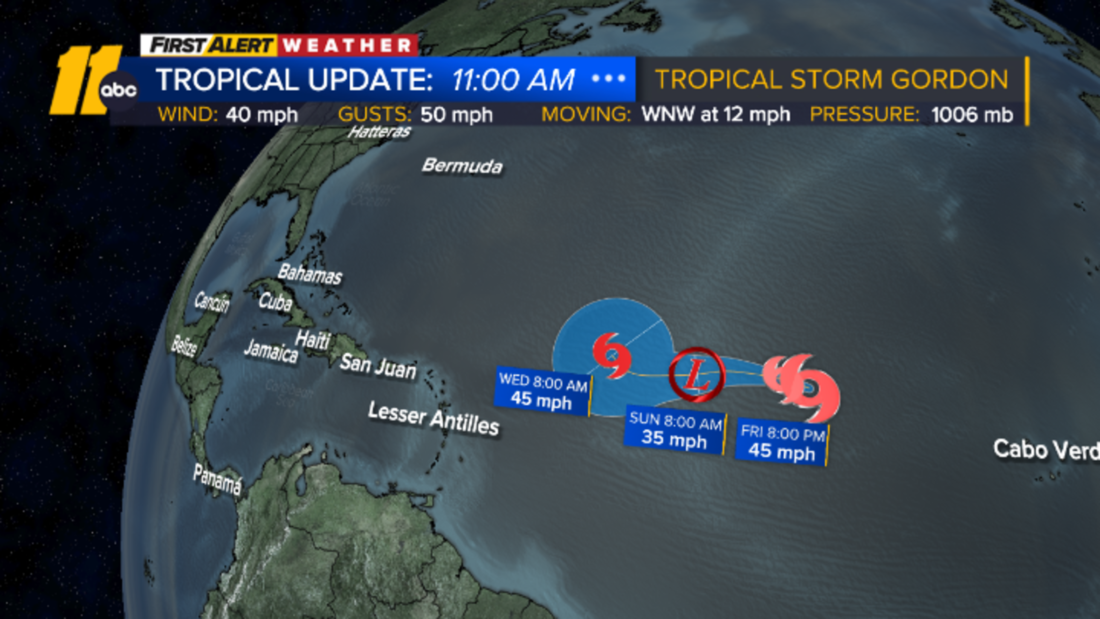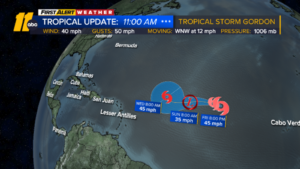
RALEIGH, N.C. — A new tropical storm has formed in the Atlantic Ocean, taking on the name Tropical Storm Gordon.
Gordon strengthened into a tropical storm Friday around 11 a.m. That’s around three days after it organized off the Cabo Verde Islands.
At 5 p.m. on Friday, the storm had maximum sustained winds of 40 mph. The storm was moving west-northwest at 10 mph and was expected to continue to strengthen for another day or so, but next week it should dissipate without ever threatening land.
Gordon formed after Francine weakened to a post-tropical cyclone.
Francine made landfall in Louisiana as a Category 2 hurricane that blacked out more than 275,000 homes and businesses. Flooding
Francine slammed into the Louisiana coast Wednesday evening with 100 mph winds in coastal Terrebonne Parish, battering a fragile coastal region that has not fully recovered from a series of devastating hurricanes in 2020 and 2021. The system then lashed New Orleans with torrential rain – leaving behind widespread power outages and debris-covered streets.
Rushing water nearly enveloped a pickup truck in a New Orleans underpass, trapping the driver inside. A 39-year-old emergency room nurse who lived nearby waded into the waist-high water with a hammer, smashed the window and pulled out the driver. The rescue was captured live by WDSU.
“It’s just second nature I guess, being a nurse, you just go in and get it done, right?” Miles Crawford told The Associated Press on Thursday. “I just had to get to get him out of there.”
The water was up to the driver’s head and rising, he said.
News footage from coastal communities showed waves from lakes, rivers and Gulf waters thrashing seawalls. Water poured into city streets in blinding downpours. Oak and cypress trees leaned in the high winds, and some utility poles swayed.
At the storm’s peak, 450,000 people in Louisiana were without power, according to the Public Service Commission. Many of the outages were linked to falling debris, not structural damage. At one point, around 500 people were in emergency shelters, officials said.
“The amount of money invested in resilience has really made a difference, from the power outages to the number of homes saved,” said Deanne Criswell, the Federal Emergency Management Agency administrator, who attended the governor’s news conference.
In the coastal community of Cocodrie in southern Louisiana, where many families own seasonal homes along the bayou for fishing, police guarded a road to prevent looting as people cleaned their properties.
Brooks Pellegrin, 50, and his family cleared muck out of their campsite, a two-story structure with a large dock on a canal about 14 miles from the Gulf of Mexico. They worked well into Thursday afternoon raking marsh grass and spraying down muddy floors after a 10-foot (3-meter) storm surge washed away the building’s back wall, porch and much of the boat deck.
“We built everything up so we wouldn’t have to do this. This one brought in a lot more water than Ida,” Pellegrin said. “It packed a lot more punch than I was expecting.”
For many in the area bordered by bayous, swamps, lakes and the Gulf of Mexico, threats of flooding and hurricanes have become a way of life, Lafourche Parish Sheriff Craig Webre said.
Water comprises about a quarter of the area in the parish, which is home to about 97,000 people south of New Orleans. In 2021, Ida made landfall in the southern point of the parish as a Category 4 hurricane with maximum sustained winds of 150 mph.
That storm was “cataclysmic” and “the most significant hurricane” to impact the area. Following the 2021 storm, 90% of homes in the area needed a roof replacement and many houses were damaged beyond repair, Webre said.
Over the years, the area has become more resilient against storms, improving drainage and pumping stations and replacing roofs that can better withstand hurricane-force winds. Residents also are evacuating quicker when there are significant storm threats, Webre said.
“This population is very resilient. They’re very independent. They’re very pioneering,” he said.











